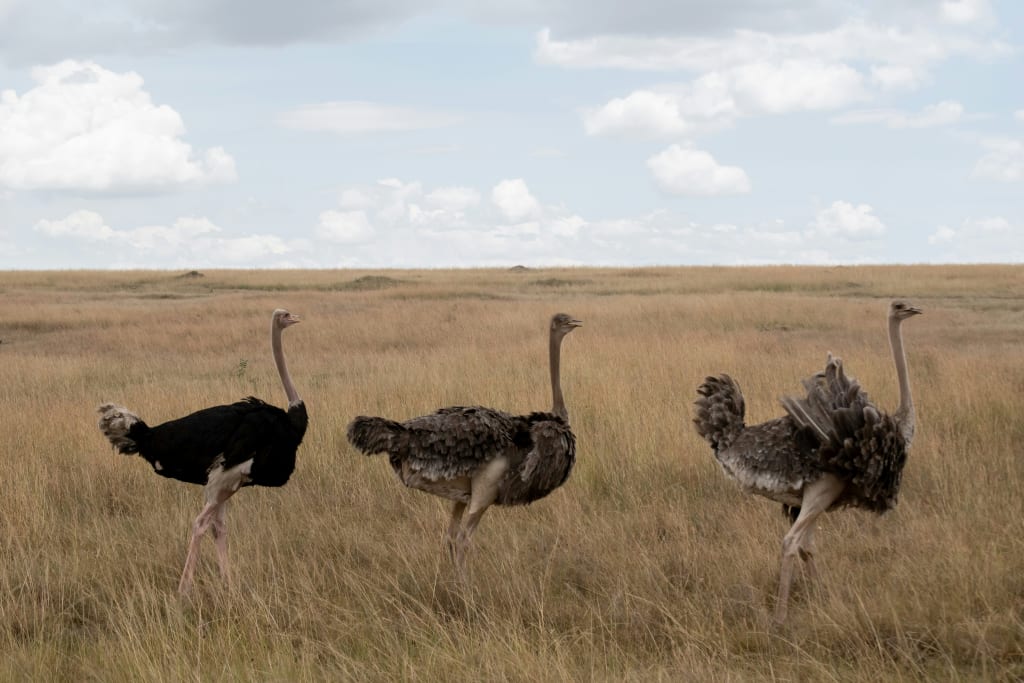"The Mighty Ostrich Kick: A Force to Be Reckoned With".
The fact that an ostrich’s legs are so powerful that their kicks can kill a lion.

Introduction:
In the vast and diverse realm of the animal kingdom, the ostrich emerges as a true powerhouse. Known for its remarkable speed and flightless nature, the ostrich possesses a unique weapon in its arsenal — its legs. These legs, incredibly powerful and muscular, are not merely tools for rapid running but lethal weapons capable of delivering kicks that can be fatal even to apex predators such as lions. In this exploration, we delve into the anatomy, behavior, and ecological significance of the ostrich's mighty kick, shedding light on the extraordinary adaptability of this iconic bird.
Chapter 1: Anatomy of Power: Ostrich Legs Unveiled.
The ostrich (Struthio camelus) is the world's largest and heaviest bird, native to the vast grasslands and savannas of Africa. Standing up to 9 feet (2.7 meters) tall, the ostrich's powerful legs are essential for its survival in the harsh and dynamic landscapes it calls home.
A distinctive feature of the ostrich's legs is the unique structure of its feet. Unlike most birds, which have three or four toes, the ostrich has only two toes on each foot. The larger, inner toe bears a formidable claw, while the smaller, outer toe is vestigial. This adaptation provides the ostrich with enhanced stability and speed, allowing it to navigate uneven terrains with agility.
Chapter 2: The Mighty Kick: A Formidable Defense Mechanism.
While ostriches are renowned for their incredible running speed, capable of reaching up to 45 miles per hour (72 km/h), it is their powerful kicks that truly set them apart in the animal kingdom. The ostrich's legs are equipped with strong muscles and tendons, particularly the powerful thigh muscles, which generate an impressive amount of force.
Ostriches employ their formidable kicks primarily as a means of defense. When confronted by a potential threat, an ostrich may choose to flee, reaching incredible speeds in the process. However, if escape is not an option, the ostrich can deliver a forceful kick that can deter or even incapacitate predators, including large carnivores like lions.
Chapter 3: The Mechanics of the Kick.
The ostrich's kick is a display of biomechanical prowess, with the entire force concentrated in a single, precise motion. The primary weapon in this arsenal is the powerful thigh muscle, which contracts rapidly, propelling the leg forward with remarkable speed. The result is a forceful impact that can crush bones and cause severe injury.
Interestingly, the kick is not a simple forward motion; instead, the ostrich employs a sweeping arc, utilizing the entire length of its powerful leg. This technique enhances the effectiveness of the kick and increases the likelihood of making contact with a potential threat. The accuracy and force of the kick make it a formidable defense mechanism, deterring predators and providing the ostrich with a crucial advantage in the struggle for survival.
Chapter 4: Ecological Significance: Balancing Act in the Wild .
The ostrich's powerful kick is not only a means of defense but also a crucial aspect of its role in the ecosystem. As a herbivore, the ostrich plays a role in shaping plant communities by controlling vegetation through grazing. The ability to defend against predators ensures the ostrich's survival, allowing it to contribute to the balance of predator-prey relationships in its habitat.
In the dynamic ecosystems of Africa, where predators such as lions are essential for maintaining biodiversity, the ostrich's ability to defend itself against predation is a vital component of the intricate web of life. It exemplifies the delicate balance that exists between species and the adaptations that have evolved over millennia to ensure their survival.
Chapter 5: Conservation Challenges and Future Outlook.
While the ostrich's mighty kick has evolved as a powerful defense mechanism, it does not exempt this iconic bird from the conservation challenges it faces in the modern world. Habitat loss, human-wildlife conflict, and hunting for feathers, meat, and eggs contribute to the pressures on ostrich populations.
Conservation efforts must focus on preserving the natural habitats of ostriches, implementing sustainable land management practices, and raising awareness about the importance of coexistence between humans and wildlife. By understanding and appreciating the remarkable adaptations of the ostrich, we can contribute to the conservation of this species and the ecosystems it inhabits.
Conclusion:
The ostrich's legs are not merely instruments of mobility; they are weapons of survival, finely tuned by evolution to deliver a powerful and precise kick. The ability of ostriches to fend off predators, even formidable ones like lions, showcases the marvels of adaptation in the natural world. As we marvel at the might of the ostrich kick, we are reminded of the intricate interplay of anatomy, behavior, and ecological significance that defines life in the animal kingdom. It is our responsibility to ensure the continued existence of these incredible creatures and the ecosystems they inhabit, appreciating the role they play in the tapestry of life on Earth.





Comments
There are no comments for this story
Be the first to respond and start the conversation.